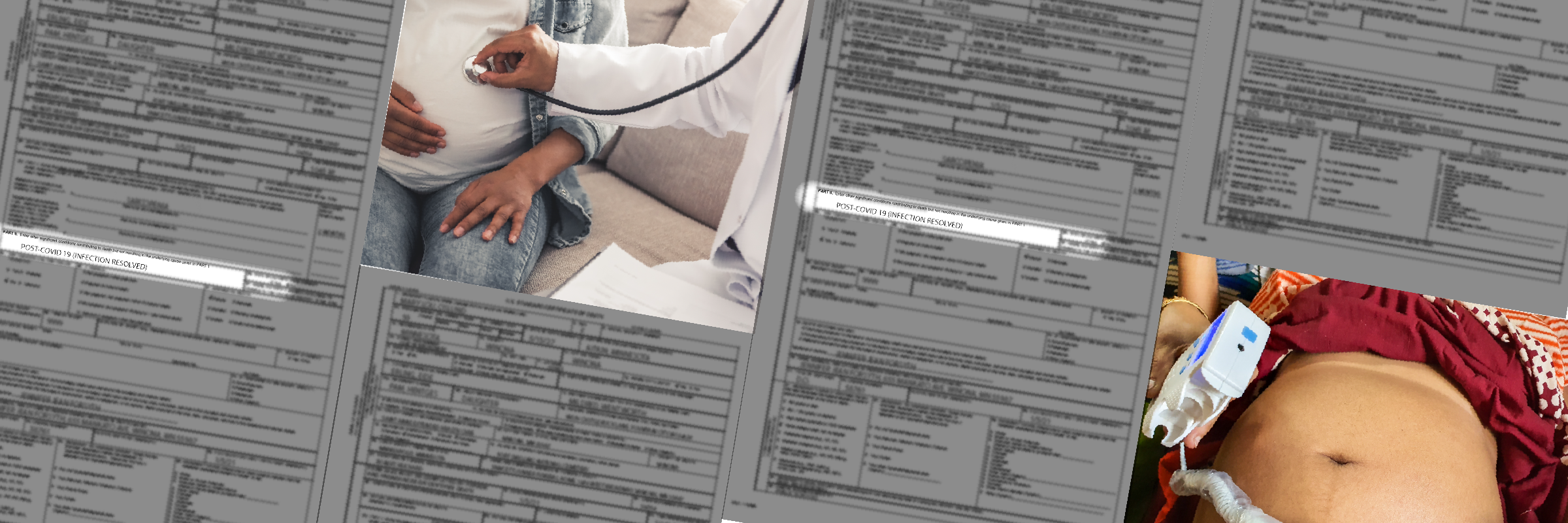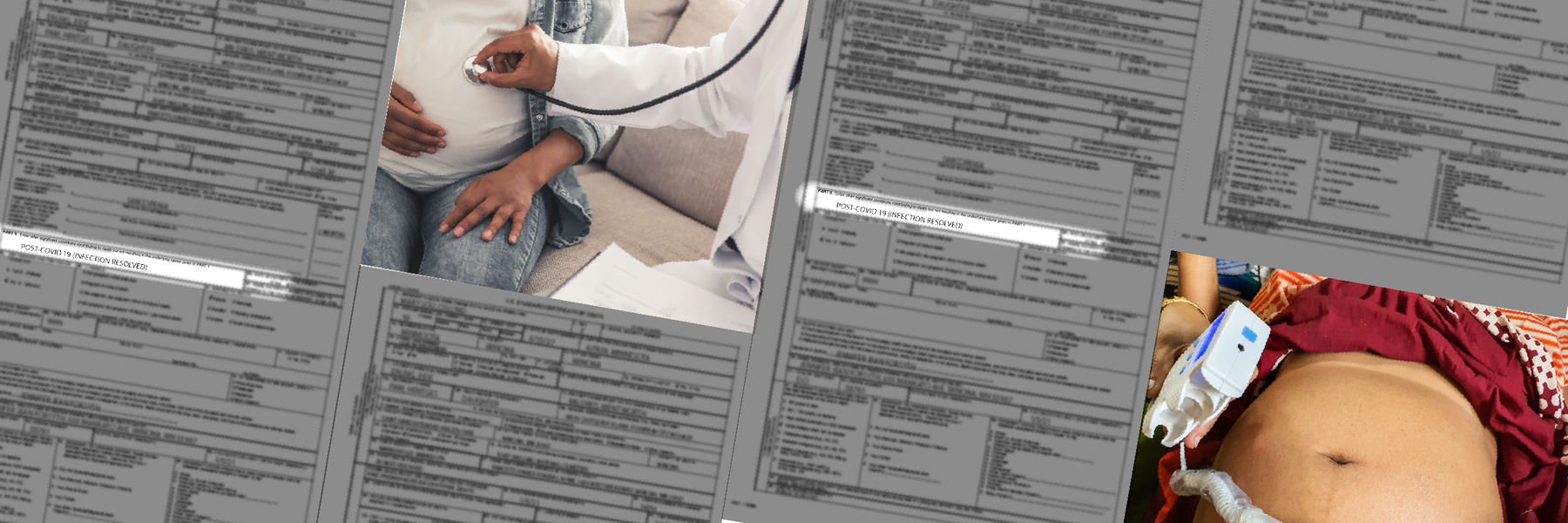Before the pandemic, the United States had the highest maternal mortality rate among affluent nations, reflecting a multitude of systemic problems, from racial disparities in medical treatment and outcomes to high rates of chronic disease among people of child-bearing age to a lack of access to postpartum healthcare for many new mothers.
Since the arrival of COVID-19, the rate of maternal death for women aged 15 to 44 in the U.S. has only gotten worse, new data shows, rising from a rate of nearly 29 maternal deaths per 100,000 births in 2019 to 45.6 in 2021.
Despite the availability of COVID vaccines and a nationwide push to bolster the health of new mothers, the rate of maternal mortality in 2022 will almost assuredly end up at the same level or higher than pre-pandemic 2019, according to our analysis.
Through the first nine months of 2022, the provisional maternal death rate stood at 30.9 per 100,000 births. (More about our data and methodology for our ongoing maternal health project can be found on our GitHub repository here.)
The still-incomplete figures from the U.S. Centers for Disease Control’s National Center for Health Statistics, which have been analyzed by journalists and computer scientists at MuckRock and reviewed by leading maternal mortality experts, underscore the lingering and devastating consequences of the pandemic on maternal health.
Maternal deaths reached their peak during the Delta variant surge in the fall and winter months of 2021, exacerbated by delays in treatment for women with pre-existing chronic conditions and maternal complications unrelated to COVID.
The preliminary data also suggests that maternal deaths remained at high levels in 2022. Some of the chief reasons, experts say: Lower birth rates for comparatively healthy pregnancies and an increase in riskier pregnancies.
Experts point to several factors causing rise in maternal deaths
Tragically, most deaths of new mothers are preventable. Recent research by state maternal mortality review committees and the CDC — covering more than 1,000 deaths in 36 states between 2017 and 2019 — showed that more than 80% of maternal deaths were preventable.
During the pandemic, the types of maternal deaths changed significantly. Causes associated with viral diseases, such as COVID-19, and respiratory conditions, such as pneumonia, became the Nos. 1 and 2 leading causes of death for mothers, overtaking cardiovascular conditions, said Marie Thoma, a reproductive and perinatal epidemiologist and population health scientist at the University of Maryland who worked for the CDC on maternal health data.
“The direct impact of COVID-19 on maternal death is notable in 2021,” Thoma said. “In our research, we find that ‘viral diseases complicating pregnancy’ rose to become the most common cause of maternal death in 2021.”
Researchers are still sorting through the data but have begun honing in on pregnant women delaying treatment for various conditions and the hesitancy of some women to get vaccinated against COVID-19 during their pregnancies, said Zsakeba Henderson, who served as the chief medical officer for the March of Dimes and who worked as a medical officer for the CDC’s Reproductive Health and Maternal and Infant Health Branch.
Beyond the COVID-19 virus, substance abuse and mental health issues have contributed to the rise in deaths of pregnant women, namely suicides and domestic violence-related homicides.
The demographic profile of the women who are dying at increasingly higher rates is also shifting, with Black, Hispanic and Native women faring worse during the pandemic.
In North Carolina, where just 22% of the population is Black, 43% of the state’s 202 pregnancy-related deaths between 2020 and 2022 were Black women. This is despite the fact that many of these deaths occurred under the care of a doctor; In North Carolina, white mothers were more than twice as likely to die at home instead of an inpatient hospital setting compared to Black mothers.
And it’s not just Black women who are disproportionately impacted.
In Minnesota, where Native and Indigenous women make up just 2% of the state’s birthing population, they made up roughly 11% of maternal, pregnancy-associated deaths during the pandemic, state data shows.
Outside research published in Obstetrics & Gynecology also found comparatively high pregnancy-related mortality among American Indian and Alaska Native people, a group that also experienced higher rates of overall COVID-19 mortality in 2021.
The leading causes of death between women of color and non-Hispanic white mothers differ markedly. For example, a third of Black mothers die from cardiac and coronary conditions, said Dr. David Goodman, who leads the CDC’s Maternal Mortality Prevention Team. As a solution, Dr. Goodman and his team have advocated focusing on those comorbidities.
“If you want to address the disparity, here’s the opportunity,” he said.
However, the overturning of Roe v. Wade by the Supreme Court has created another challenge: The increase in at-risk pregnant mothers carrying fetuses to term, with potentially deadly consequences for women, said Katy B. Kozhimannil, a health policy professor at the University of Minnesota who focuses on pregnancy and childbirth.
“When people don’t have access to contraception or the ability to terminate a pregnancy that is unwanted or not healthy for them, the pregnancies that people are trying to seek abortions for tend to also be the riskiest,” she said.
There are also geographic differences, namely urban and rural. Researchers have found that medium-to-small metro and rural areas saw a larger increase in pregnancy-related deaths than large urban areas in 2021, reflecting a larger shift of COVID-19 mortality to non-urban areas that year. Similarly, the South saw large increases in both the sheer number and rate of maternal deaths — doubling from 471 deaths in 2018 to exactly 900 in 2021.
That trend appears to be continuing in 2022.
Yet despite the worsening trends, there have been visible gains in the treatment and outcomes of pregnant women in inpatient hospital facilities.
For example, U.S. hospitals have greatly improved how they manage instances of obstetric hemorrhage in recent years, the data shows. The number of women accessing prenatal care in the first trimester has climbed. Tobacco use during pregnancy, a substantial health risk factor for both new mothers and newborns, dropped by more than a third between 2016 and 2021, new research has found.
But with maternal death rates continuing to climb, experts remain circumspect.
Said Kozhimannil: “We can’t pat ourselves on the back, because the numbers are really bad.”
How we compiled U.S. maternal mortality data
To analyze the CDC death data, MuckRock signed a data-use agreement with the federal government in 2021 for access to their monthly statistics. Similar to a GAO report released in October, MuckRock took these federal death statistics and developed ratios between the number of deaths and the number of live births in a given month and year.
We also went a step further than the GAO, sharing our findings with academic experts in maternal health, creating our own historical analysis of maternal mortality rates, and dug into 2022 trends with the help of researchers at the University of Maryland and the University of Wisconsin to determine expected monthly and full year death rates for 2022.
As a final step, we collected exhaustive death certificate data from a subset of states that allow for public access of those records: Michigan, Minnesota and North Carolina. By analyzing individual records from those three states — including where a person died, the cause of death listed on a death certificate and other contributing causes — we were able to get a more nuanced picture of why U.S. mothers are dying at such high rates.
Some important context: In the two decades before the pandemic, the U.S. maternal death rate had risen slowly but steadily. But the increase was mostly due to better data collection, after U.S. health officials began putting a checkbox on death certificates to indicate whether a deceased woman was pregnant within one year of her death.
Still, the high maternal mortality rates in the 2000s and 2010s left the U.S. as a startling outlier amongst high-income countries, with maternal death rates more than three times higher than France, Canada and the United Kingdom.
Mothers in the U.S. face a host of obstacles that put them at greater risk, experts say, including high (and increasing) rates of cesarean sections; elevated rates of chronic illnesses such as obesity, diabetes and heart disease; comparatively high rates of mental illness; delayed or skipped medical treatment due to costs; a severe shortage of midwives in the U.S. healthcare system; and social policies such as a lack of paid maternity leave.
The CDC’s maternal death rates rely on death certificates, which can be inaccurate or omit key information depending on the attending physician or certifier. As a result, the federal data is an undercount of the true death toll to U.S. mothers.
To get a fuller picture, many states use maternal mortality review committees — panels of experts convened to look closely at a sample of deaths. These experts, which include physicians and social workers, look at a patient’s full medical history.
Those committees differ from state to state but they largely come to the same conclusion: Maternal deaths recorded by federal data are somewhere between 30% and 40% lower than the figures from death certificates, said Dr. Goodman of the CDC’s Maternal Mortality Prevention Team.
Still, the death certificate data gives us the most up-to-date national statistics currently available on the number of mothers who die during or up to a year after childbirth. And while death certificates, state review committees and the CDC’s more-robust Pregnancy Mortality Surveillance System, which links birth and death records and relies on medical epidemiologists to review deaths from across the country, differ in how they collect data, they all consistently reach similar conclusions.
And the death certificate data paints a grim picture for new mothers, especially women of color.
Since 2019, the Black maternal death rate has soared more than 59% in just two years, from 43.5 per 100,000 births to 55.3 in 2020 to a staggering 69.9 in 2021. By comparison, the white maternal death rate stood at 26.1 per 100,000 births in 2021, a 47% increase from two years earlier.
The 2021 Black maternal death rate is now almost three times higher than that of white women.
And the COVID-19 virus, along with its punishing strain on the U.S. healthcare system, has only made things worse for pregnant women, the data reveals.
Many of the 2021 deaths appear concentrated in the fall and wintertime months of the deadly Delta COVID surge; 425 women who died from pregnancy-related complications in 2021 also have COVID-19 listed on their death certificates as a contributing factor.
And so far this year, at least 1,142 mothers have died from pregnancy-related complications — an incomplete and partial figure that will substantially rise and take several more months to be fully counted.




